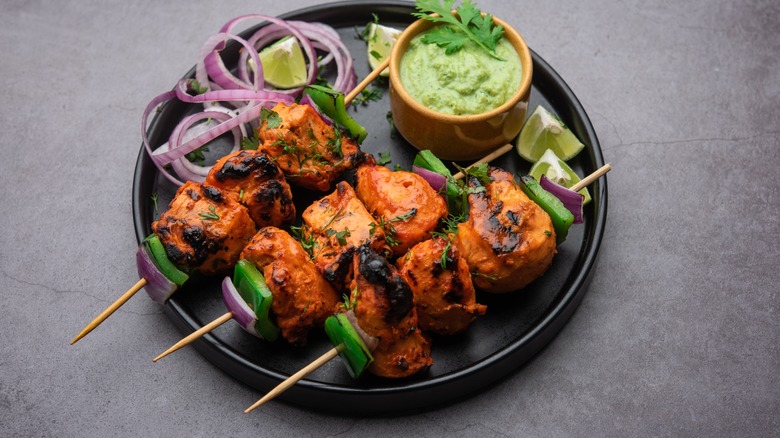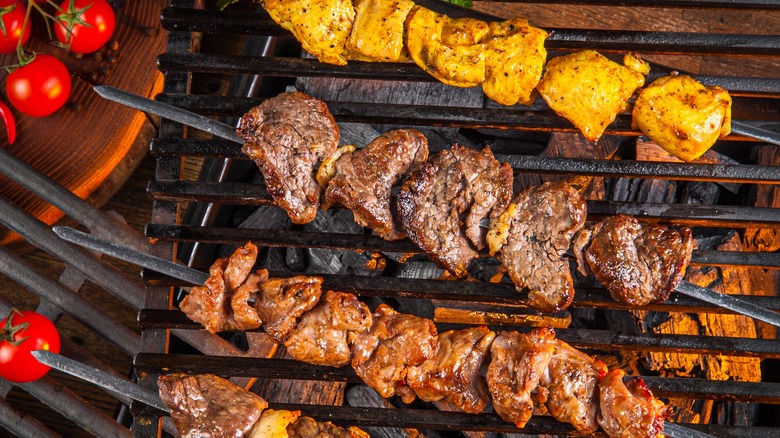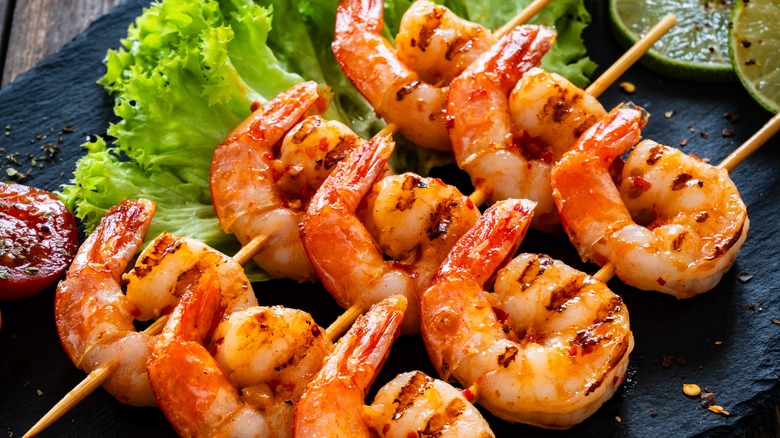The Prep Mistake That's Ruining Your Grilled Skewers
When it comes to classic grilled preparations, skewers are among the most fun. Eating food from a stick always feels whimsical, and makes for a great party presentation. They're also super functional; you can cook skewers more quickly, for example, since the pieces of food you use will be smaller, and they're ideal for dunking in a homemade dip or even wrapping in a tortilla after removing the stick for a twist on taco night.
That said, there are also ways that grilling skewers can go wrong, and there's a particular kind of disappointment when you pull one off the grill and the elements you've carefully threaded onto your stick are unevenly cooked. Fortunately, this is one error that can be preempted in the prepping process. Among the considerations that will help you create a satisfying skewer experience, one of the most critical is ensuring that all your elements are cut to roughly the same size, as this tip will make a major difference when it comes to cooking consistency.
Uniformity is key when grilling skewers
When your food is cut into similarly sized pieces, each will have more or less the same surface area. This means the heat from your grill can reach every morsel for about the same time, and on all sides as you turn your sticks throughout the grilling process. While this same-size prep tip is perfect for skewers, the same principle can be applied to anything you're cooking off the stick as well. Whether you're grilling, roasting, baking, or air-frying proteins, fruits, or veggies, uniformity among your ingredients will always be useful for consistency.
Uniformity beyond size and shape is important when it comes to skewers, too. Perhaps you've made kebabs in which your onions scorched while your steak was too rare, or your carrots were tough and crunchy while your squash went beyond pleasantly tender. That's because some elements — no matter how similar in shape and size — will still have different cooking requirements.
With that in mind, although it may be fun to have a spectrum of items on your skewer, the most sound cooking strategy is to keep all the same ingredient (cut to the same size) on a single stick. This means one skewer for mushrooms, one for beef, one for shrimp, and so forth. You can always mix and match afterward, but you'll have a much better chance at achieving consistent results when you skewer the same ingredients together.
Select the best ingredients for your skewers
When creating your menu, give some thought to what you choose to skewer, too, as certain ingredients will fare better than others with this high heat, quick-cook method. When it comes to seafood, you'll have better luck with shellfish like scallops or a grilled shrimp skewer recipe that is both sweet and simple, or firmer, heartier options like swordfish. For meat selections in general, the leaner the protein, the less desirable for your skewering purposes, so reach for beef and pork cuts that have some fat and marbling; they'll have a better chance at retaining moisture. Chicken breast is also more likely to become dry and tough when cooked on a skewer than dark meat like the thigh. On the veggie front, corn, tomatoes, mushrooms, onions, bell peppers, and eggplant are all great options, and tofu skewers with green goddess sauce is a tasty take for the non-meat eaters at your table. Fruits like pineapple and peaches caramelize beautifully when grilled, and bring sweet and tart pops to your picnic's menu, too.
If you must opt for a mixed ingredient skewer, it'll help to strategize which foods call for similar cooking time and temperature, or whether any items can be pre-treated to help the process (for example, not precooking carrots before grilling is a mistake). Either way, following these simple tips for a little advance planning will help ensure your skewer party is a great grilling success.


